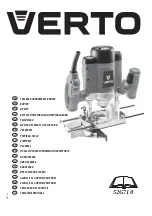
11 − English
OPERATION
To guard against kickback, plan the setup and direction of
feed so that you will always be thrusting the tool in the same
direction that the leading edge of the bit is moving. The
thrust should be in a direction that keeps the sharp edges
of the bit continuously biting straight into new (uncut) wood.
NOTE:
For best results, make sure to take enough time to
set up for cutting. While cutting, make sure to use the proper
rate of feed.
PROPER RATE OF FEED
Professional routing depends upon careful setup and proper
rate of feed which is learned through practice and use. The
proper rate of feed is dependent upon:
hardness and moisture content of the workpiece
depth of cut
cutting diameter of the bit
When cutting shallow grooves in soft woods such as pine,
a faster rate of feed can be used. When making cuts in
hardwoods such as oak, a slower rate of feed is required.
Several factors will help you select the proper rate of feed.
Choose the rate that does not slow down the motor.
Choose the rate at which the bit advances firmly and
surely to produce a continuous spiral of uniform chips
or a smooth edge.
Listen to the sound of the motor. A high-pitched sound
means you are feeding too slowly. A strained, lower
pitched sound signals force feeding.
Check the progress of each cut. Too slow feeding can
cause the router to take off in a wrong direction from the
intended line of cut. Force feeding increases the strain
of holding the tool and results in loss of speed.
Notice the chips being produced as you cut. If the router
is fed too slowly, it will scorch or burn the wood. If fed
too fast, it will take large chips out of the wood and leave
gouge marks.
Test a cut on a scrap piece of the workpiece before you begin.
Always grasp and hold the router firmly with both hands.
If you are making a small diameter, shallow groove in soft,
dry wood, the proper feed rate may be determined by the
speed at which you can travel the router along the guide line.
If the bit is a large one, the cut is deep, or the workpiece is
hard to cut, the proper feed may be a very slow one. A cross
grain cut may require a slower pace than an identical with
grain cut in the same workpiece.
FEEDING TOO FAST
See Figure 16, page 17.
Clean, smooth routing and edge shaping can be done only
when the bit is revolving at a relatively high speed and is
taking very small bites to produce tiny, cleanly severed chips.
If you force the router to move forward too fast, the RPM of
the bit becomes slower than normal in relation to its forward
movement. As a result, the bit must take bigger bites as it
revolves. Bigger bites mean bigger chips and a rougher
finish. Also, because bigger bites require more power, the
router motor may become overloaded.
Under extreme force-feeding conditions, the relative RPM
of the bit can become so slow—and the bites it has to take
so large—that chips will be partially knocked off (rather
than fully cut off). This causes splintering and gouging of
the workpiece.
The router is an extremely high-speed tool, and will make
clean, smooth cuts if allowed to run freely without the overload
of a forced feed. You can always detect force feeding by the
sound of the motor. Its high-pitched whine will sound lower
and stronger as it loses speed. Also, the strain of holding
the tool will be noticeably increased.
FEEDING TOO SLOWLY
See Figure 17, page 17.
It is possible to spoil a cut by moving the router forward too
slowly. When you advance the router into the work too slowly,
the revolving bit does not dig into new wood fast enough
to take a bite; instead, it merely scrapes away sawdust-like
particles. Scraping produces heat, which can glaze, burn,
or mar the cut and in extreme cases, can overheat the bit,
destroying its hardness.
When the bit is scraping instead of cutting, controlling the
router is more difficult. With practically no load on the mo-
tor, the bit revolves at close to top RPM, and has a much
greater than normal tendency to bounce off the sides of
the cut (especially if the wood has a pronounced grain with
hard and soft areas). As a result, the cut produced may have
rippled, instead of straight, sides.
Feeding too slowly can also cause the router to take off in a
wrong direction from the intended line of cut. Always grasp
and hold the router firmly with both hands when routing.
You can detect when you are feeding the router too slowly by
the runaway, high-pitched sound of the motor or by feeling
the wiggle of the bit in the cut.
Содержание RE180PL1
Страница 14: ...14 English NOTES ...
Страница 27: ...14 Français NOTES ...
Страница 40: ...14 Español NOTAS ...












































